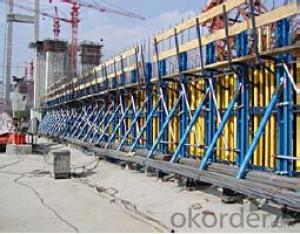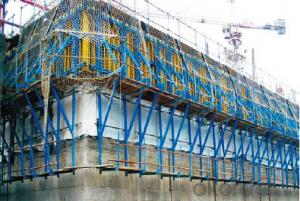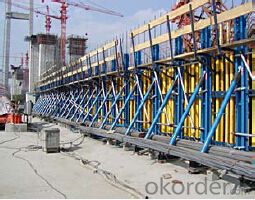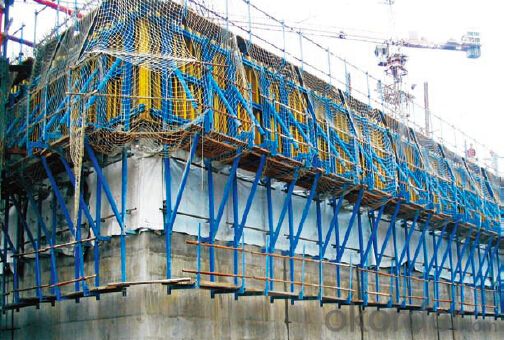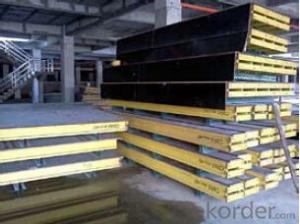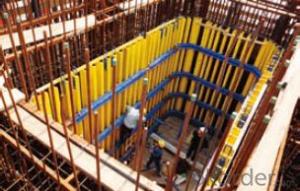Single-Side Climbing Bracket for formwork and scaffolding system
- Loading Port:
- Tianjin
- Payment Terms:
- TT OR LC
- Min Order Qty:
- 50 m²
- Supply Capability:
- 1000 m²/month
OKorder Service Pledge
OKorder Financial Service
You Might Also Like
Single-side Climbing Bracket SCB180:
With CNBM SCB 180 climbing systems, the loads from the fresh concrete pressure are
transferred through the brackets by means of V-strongbacks and compression braces into the
scaffold anchors.
Typical applications for the SCB 180 are dams, locks, cooling towers, pier heads, tunnels, and
bank vaults.
The formwork is simply tilted backwards when striking takes place. The 1.80 m wide bracket
requires only a minimum of space.
Characteristics:
◆ Economical and safe anchoring
The M30/D20 climbing cones have been designed especially for single-sided concreting using
SCB180 in dam construction, and to allow the transfer of high tensile and shear forces into the still
fresh, unreinforced concrete. Without wall-through tie-rods, finished concrete is perfect.
◆ Stable and cost-effective for high loads
generous bracket spacings allow large-area formwork units with optimal utilization of the bearing
capacity. This leads to extremely economical solutions.
◆ Simple and flexible planning
With SCB180 single-sided climbing formwork, circular structures can also be concreted without
undergoing any large planning process. Even use on inclined walls is feasible without any special
measures because additional concrete loads or lifting forces can be safely transferred into the
structure.
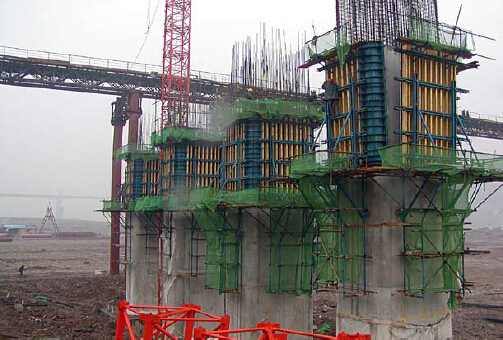
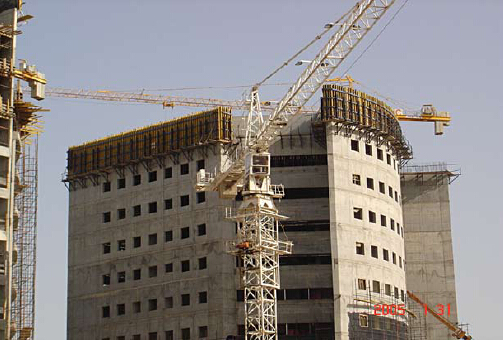
- Q: How does steel formwork affect the overall construction site safety?
- Construction sites widely utilize steel formwork due to its strength, durability, and reusability, which play a crucial role in enhancing safety measures. The secure and stable structure provided by steel formwork during concrete pouring minimizes the risk of collapse or failure, thereby reducing the likelihood of accidents like falls. Additionally, the ability of steel formwork to withstand high pressures exerted by wet concrete ensures the desired shape and structure of the concrete, reducing the risk of structural defects or weaknesses. The easy assembly and disassembly of steel formwork facilitate efficient installation and removal, minimizing the time spent on the construction site and exposure to potential hazards. Customizability and tailoring of steel formwork ensure precise concrete placement, minimizing the need for rework and preventing accidents or injuries arising from incorrect placements. Furthermore, the reusability of steel formwork reduces waste and the associated risks of tripping hazards or material obstructions on the site, creating a safer working environment. Overall, steel formwork significantly enhances construction site safety by providing stability, preventing structural defects, reducing construction time, enabling precise placements, and minimizing waste. Its robust and reliable nature ensures a secure working environment and reduces potential risks and hazards.
- Q: What are the different types of steel formwork joints and connections?
- Construction commonly utilizes various types of steel formwork joints and connections. These encompass: 1. Butt Joint: This basic joint joins two formwork panels by placing them alongside each other and securing them with bolts or clamps. It is a straightforward and efficient method. 2. Lap Joint: In this joint, two formwork panels overlap and are fastened together with bolts or clamps. It offers greater strength and stability than a butt joint. 3. Corner Joint: Corner joints connect formwork panels at right angles, typically in wall or column corners. They can be created by overlapping panels or using specialized corner connectors. 4. T-Joint: T-joints occur when three formwork panels intersect at a right angle, with one panel forming the stem of the "T". They are frequently employed in beam or slab construction. 5. Hinged Joint: Hinged joints are useful when formwork panels need adjustable connections at specific angles. They enable flexibility in formwork assembly and alignment. 6. Wedge Joint: This joint involves inserting wedges into pre-cut slots or grooves in formwork panels. It ensures a secure and tight connection. 7. Tie Rod Joint: Tie rod joints connect formwork panels using threaded steel rods. They are often found in large-scale construction projects requiring high load-bearing capacity. 8. Pin Joint: Pin joints are formed by inserting steel pins into pre-drilled holes in formwork panels. They establish a rigid connection. Each joint or connection type offers distinct advantages and is selected based on project-specific requirements. Factors such as load-bearing capacity, formwork design, and ease of assembly and disassembly influence the choice of joint type.
- Q: Can steel formwork be used in heritage or conservation projects?
- Yes, steel formwork can be used in heritage or conservation projects. Steel formwork offers several advantages that make it suitable for such projects. Firstly, steel formwork is highly durable and long-lasting, which is crucial when working on historic structures that require preservation for future generations. It can withstand the rigors of construction and can be reused multiple times, making it a cost-effective solution. Additionally, steel formwork provides excellent strength and stability, ensuring accurate and precise concrete placement. This is especially important in heritage projects where maintaining the original design and structural integrity is crucial. The versatility of steel formwork also allows for complex shapes and intricate detailing, making it suitable for replicating historic architectural features. Furthermore, steel formwork is highly resistant to warping, shrinking, or expanding due to temperature changes and moisture, which can be common in conservation projects. This resistance ensures that the formwork remains stable throughout the construction process, minimizes the risk of damage to the heritage structure, and helps maintain the overall structural integrity. However, it is important to consider the specific requirements and restrictions of each heritage or conservation project. Some projects may have strict guidelines that require the use of traditional materials, in which case steel formwork may not be suitable. It is essential to consult with heritage experts and conservation specialists to ensure that the use of steel formwork aligns with the project's objectives and meets all necessary preservation standards.
- Q: Can steel formwork be used for theater construction projects?
- Yes, steel formwork can be used for theater construction projects. Steel formwork offers durability, strength, and flexibility, making it suitable for creating complex shapes and structures required in theater construction. It provides a solid framework for creating stages, seating areas, and other components of theater spaces. Additionally, steel formwork can be easily reused and adjusted to meet the specific design requirements of theater projects.
- Q: How does steel formwork handle concrete temperature differentials?
- Steel formwork is known for its strength and durability, which allows it to effectively handle concrete temperature differentials. The thermal conductivity of steel helps in evenly distributing the heat or cold generated by the concrete during the curing process. This prevents the formation of cracks or other structural issues that can occur due to uneven temperature distribution. Additionally, steel formwork provides stability and rigidity, ensuring that the concrete maintains its desired shape and strength even when exposed to varying temperatures.
- Q: What are the different types of lifting systems used with steel formwork?
- There are several types of lifting systems commonly used with steel formwork in construction projects. These lifting systems are designed to facilitate the transportation and installation of steel formwork panels, which are used to create the molds for concrete structures. Here are some of the different types of lifting systems used with steel formwork: 1. Crane lifting system: This is one of the most common and widely used lifting systems. It involves using cranes with hooks or specialized lifting attachments to lift and move the steel formwork panels to their desired location. Cranes provide the necessary strength and stability to handle heavy loads and are often used in large-scale construction projects. 2. Forklift lifting system: Forklifts are another popular option for lifting and moving steel formwork panels. These vehicles are equipped with forks that can slide under the formwork and lift it off the ground. Forklifts are particularly useful in smaller construction sites or areas with limited space, where cranes may not be feasible. 3. Hydraulic lifting system: Hydraulic systems utilize hydraulic power to lift and move the steel formwork panels. These systems are often integrated into the formwork itself, allowing for controlled lifting and lowering of the panels. Hydraulic lifting systems are known for their precision and ease of use. 4. Manual lifting system: In some cases, manual labor is used to lift and move steel formwork panels. This method typically involves a team of workers using ropes, chains, or other lifting tools to manually hoist the formwork into position. Manual lifting systems are usually employed for smaller formwork panels or in situations where other lifting systems are not available. 5. Self-climbing lifting system: Self-climbing systems are commonly used in high-rise construction projects. These systems are designed to lift and move the steel formwork vertically as the construction progresses. They often utilize hydraulic or mechanical mechanisms to lift the formwork to the next level, allowing for efficient and continuous construction. 6. Tower crane lifting system: Tower cranes are tall, freestanding cranes that are commonly used in large construction projects. They can lift and move steel formwork panels to various heights and locations on the construction site. Tower cranes offer excellent reach and versatility, making them suitable for projects with complex formwork requirements. Overall, the choice of lifting system for steel formwork depends on factors such as the size and weight of the formwork panels, the construction site's characteristics, and the specific requirements of the project. It is important to select the appropriate lifting system to ensure the safe and efficient installation of steel formwork.
- Q: How does steel formwork handle formwork stripping time?
- Steel formwork is renowned for its durability and strength, characteristics that contribute to its exceptional efficiency in handling formwork stripping time. Unlike traditional wooden formwork, steel formwork has the capacity to endure multiple uses while maintaining its structural integrity. As a result, the stripping time required for steel formwork is significantly reduced when compared to other formwork materials. The rigid construction of steel formwork allows it to bear the weight of concrete and resist deformation during the pouring and curing processes. Consequently, the formwork can be removed more quickly once the concrete has set, as there is less concern about damaging or distorting the formwork. Furthermore, the design of steel formwork incorporates smooth and non-porous surfaces. This characteristic prevents the concrete from bonding with the formwork, facilitating an easier and faster stripping process. Additionally, the smooth surface contributes to a superior finish of the concrete, reducing the need for additional finishing work. Moreover, steel formwork systems often include adjustable features such as adjustable props and modular panels. These features enable easy adjustment and repositioning of the formwork, further enhancing the efficiency of the stripping process. This adaptability allows for faster stripping and reusability of the formwork, resulting in significant time and cost savings. In conclusion, steel formwork excels in managing formwork stripping time due to its durability, strength, and smooth surface. Its ability to withstand multiple uses, resist deformation, and prevent concrete adhesion makes steel formwork highly efficient and time-saving in the construction industry.
- Q: How does steel formwork handle different concrete mix designs?
- Steel formwork is known for its versatility and ability to effectively handle different concrete mix designs. The strength and durability of steel make it a suitable choice for accommodating a wide range of concrete mixes. One advantage of using steel formwork is its capability to withstand the pressure and weight of various concrete mix designs. Whether it is a high-strength mix or a mix with a higher water-cement ratio, steel can handle the load without any deformation or collapse. This makes it perfect for projects that require customized concrete mixes. Moreover, steel formwork ensures a smooth and even surface finish for concrete structures, regardless of the mix design. This is essential for achieving the desired aesthetic appearance of the finished product. Steel formwork guarantees that the concrete is properly contained, preventing any leaks or spills during the pouring process, resulting in a consistent and uniform finish. Additionally, steel formwork can be easily adjusted or modified to accommodate changes in concrete mix designs. Its adaptability allows for efficient construction processes and reduces the need for additional formwork materials. In summary, steel formwork is a reliable and efficient choice for handling different concrete mix designs. Its strength, durability, and adaptability make it an ideal solution for construction projects that require customized concrete mixes. Whether it is a high-strength mix or a mix with specific properties, steel formwork can effectively handle the demands of various concrete designs.
- Q: How does steel formwork impact the overall project scheduling?
- Steel formwork can significantly impact the overall project scheduling in a positive way. Its strength and durability allow for faster construction and increased efficiency, as it can be easily assembled and disassembled. Additionally, steel formwork reduces the need for extensive cleaning and maintenance, leading to time savings. Due to its reusability, steel formwork eliminates the waiting time for new forms to be fabricated, resulting in shorter project durations and improved project scheduling.
- Q: Is steel formwork suitable for projects with high architectural demands?
- Projects with high architectural demands can benefit greatly from the use of steel formwork. The durability of steel formwork enables it to withstand the pressures and forces experienced during construction, ensuring that it maintains its shape and integrity. As a result, precise and accurate concrete structures can be achieved. In addition to its durability, steel formwork offers versatility and customization options to meet specific architectural requirements. It can easily be shaped and designed to create intricate and unique structures, making it ideal for projects that require complex architectural elements. Furthermore, the use of steel formwork results in high-quality finishes on concrete surfaces. The smooth and uniform surfaces created by steel formwork reduce the need for additional finishing work. This is particularly important for projects with high architectural demands, where attention to detail and aesthetic appeal are crucial. Moreover, steel formwork provides excellent strength and stability, ensuring that concrete structures maintain their shape and remain intact over time. This is especially important in projects with high architectural demands, where structural integrity is of utmost importance. In summary, steel formwork is a suitable choice for projects with high architectural demands due to its durability, versatility, high-quality finish, and strength. It allows for the creation of visually appealing structures while ensuring long-term performance and structural integrity.
Send your message to us
Single-Side Climbing Bracket for formwork and scaffolding system
- Loading Port:
- Tianjin
- Payment Terms:
- TT OR LC
- Min Order Qty:
- 50 m²
- Supply Capability:
- 1000 m²/month
OKorder Service Pledge
OKorder Financial Service
Similar products
Hot products
Hot Searches
